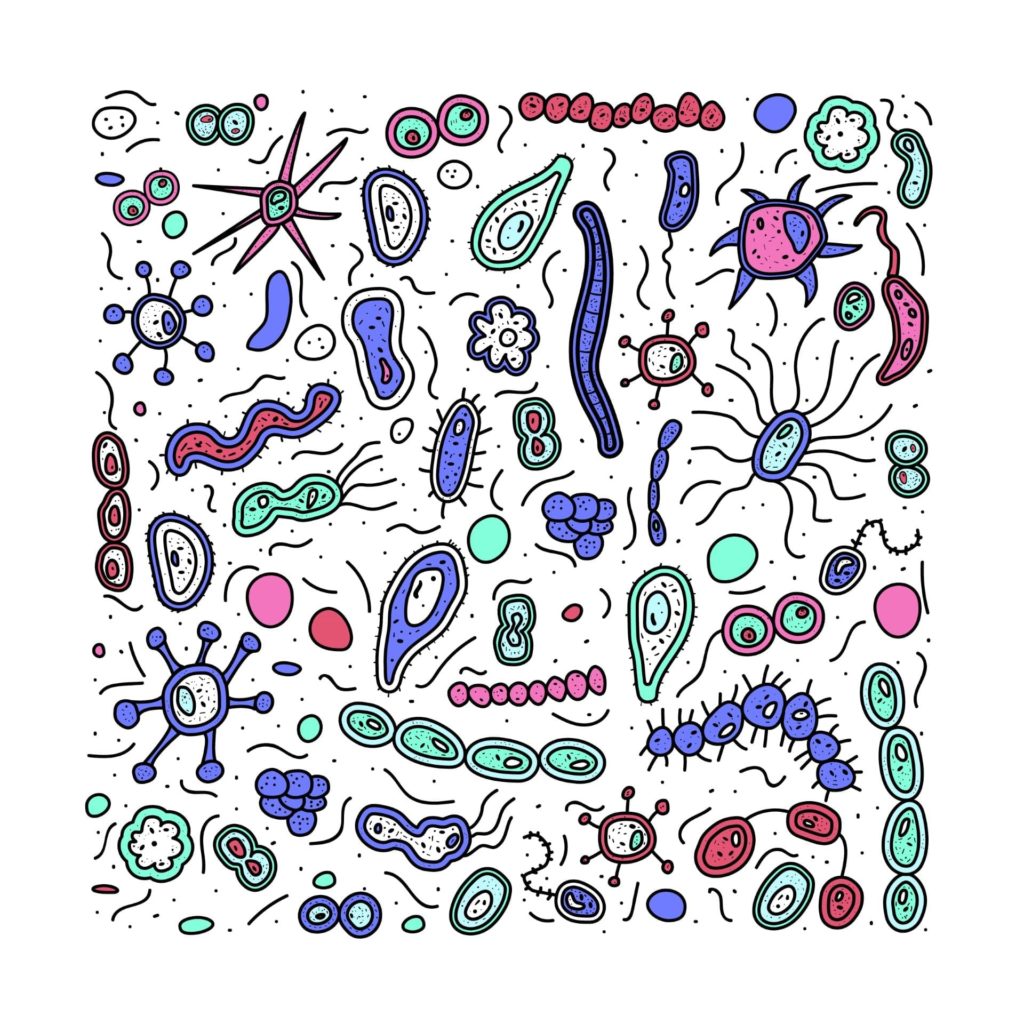Once upon a time, scientists thought that skin was just like a kind of physical bag to keep your squishy bits in.
Now we know better.
Now we know that your skin – and the trillions of friendly commensal bacteria that co-habit there – is actually the first line of defence to your immune system.
Breach this barrier, and your system is going to go crazy – and justly so.
Why does dry skin trigger your immune defenses?
I could chuck a bunch of complicated science at you here, but if you’re anything like me, that will make your eyes roll back in your head. So I’ll show you, instead!
To understand it properly, let’s get small. Wave a magic shrinking wand *swish and flick * and we have now turned you into a B Cell. You’re now a newly trained, fully functioning member of your own immune system.
So, here you are, freshly graduated from B Cell school. You’re on patrol, in the skin area of the border. First day on the job.
You’re feeling pretty good about yourself. An infection fighter is a cool thing to be, from a cell’s point of view. You pat yourself down as you stroll along, checking for all your equipment.
Your Y-shaped antibody stun gun, stuck to the front of your DNA, ready to shoot at any invaders? Check. (Your weapon is fully loaded with a particular infection-fighting immunoglobulin called IgE; it’s how you’re identified.)
Big, slobbery, tail-wagging macrophage walking on a leash next to you, ready to sic on any invaders? Check. (Macrophages are cells that engulf and gobble microscopic foreign bodies – great stuff.)
And last but not least, you have your hand-grenade-style canister of TSLP. TSLP is a notification molecule, enabling you to communicate with your fellow B Cells if something goes wrong.
At the first sign of any disruption or intrusion, you’re ready to pull the pin and throw down that TSLP canister. It will immediately boil like purple smoke through the corridors of the host, alerting your B Cell compadres who are patrolling the other barrier sites in the body of the host – sinuses, lungs, and gut.
You think back to what your T-Cell trainer taught you in immune system class:
“What are you, soldiers?”
“We’re B Cells, sir!”
“And what is your job?”
“To find and fight infection, Sir!”
“And how do you do that?”
“With our antibodies, macrophages and TSLP, sir!”
“And where do you do it?”
Ermmmm… long silence. Awkward.
T-Cell pinches the bridge of his nose and sighs.
“Okay, soldiers, let’s go through it again:”
“You are part of the acquired, or memory, section of the immune system. You will be patrolling inside the immune system. The immune system is made up of all the linked barrier sites: this is any place where the host cells touch anything that comes from the outside environment. Skin, obviously, is the first place any breach will occur. Sinuses next, since that’s where the air hits the body. Lungs are the next place that intruders will land. And gut, since that’s where food contacts the system. Now, is everyone clear?”
“We’re clear, Sir!”
Back on your patrol path, you smile confidently. You are clear. You are strong. You are ready to find and fight infection.
Suddenly, up ahead, you see an invader. What is it? Gurd, it’s huge. It’s…it’s… it’s a birch pollen molecule! One of the worst allergens going. Ten times your size and looking like the ugliest monster you’ve ever seen.
How did it get in? Clearly, the host’s skin has not been producing enough good fats to keep the skin healthy and hydrated. Dry skin means chinks in the barrier, and itching. Itching means scratching, which means that foreign molecules can be physically driven deeper through the skin barrier. And that means…
“Barrier breach!” You shout, as loudly as you can. “Barrier breach! Itch alert! Invasion!”
You rip your TSLP canister off your belt, pull the pin and detonate it. Purple smoke starts to billow out of it in choking waves, spreading rapidly down the passages to alert your fellow B Cells, up in the sinuses.
Alerted, they will start to pour out loads of mucous, ready to flush out any invaders. Clouds of purple TSLP is also spreading rapidly to alert the lungs, where your fellow B Cells are standing by, ready will to constrict the airways, to prevent invaders from gaining access.
In the gut, other B Cell school mates of yours will begin to create make muscular ripples and watery fluid, ready to repel the invader.
You snap the leash off your macrophage, releasing it.
“Go get it, boy!” you encourage, and the macrophage runs forward growling, launching itself straight at the invader. You watch helplessly as the birch pollen molecule, huge as a train, bats the macrophage out of the way. The macrophage whimpers, twitches once and then lies still.
This is bad, you realise. This is serious. It’s time for the big guns.
You take a deep breath, and rip your antibody loose out of your DNA holster, holding the handle in both hands. It’s IgE time.
You vault towards the monster and stick both of the Y-ends of your DNA on the invader, trying to get full contact. It’s cell membrane is slippery, and you slide along the surface. It bats at you, but misses. It’s howling like a hurricane. You can’t get a good lock on it.
You’re going to have to go for it. You leap onto its neck, riding it like a bull, and clamp your antibody down on it again. This time you make the connection – just in time. You click the latch, lock in, and start to spray IgE. The ultimate immune system weapon, designed for parasites and viruses. My, but it’s potent. Like a fire hose, the IgE comes spraying out of your holster, straight into the invader.
It’s working…it’s slowing down…it’s starting to wrinkle and shrivel – you’ve done it! Birch pollen molecule is dying… dying… dead. Success!
Only problem? There’s now IgE loose in the system. And IgE is the main player in the allergy drama. It causes the red welts and skin disruption typical of eczema. People with eczema have been shown to have much higher levels of IgE in their systems than people who don’t have eczema. 1
Is this science fiction? Not really. (although I have embellished a few details – macrophages do eat infectious agents, for example, but I have no proof that B Cells actually walk them on leashes. Still, in the main, this is all correct.)
Scientists used to think that food allergies cause eczema.
Now, they believe that it’s the other way around – eczema comes first, and actually causes food allergies, which starts off the whole allergic march.
The problem starts with a tiny fault in your genetic code, which means that the skin is not producing enough good fats, or “bio-lipids” to keep skin healthy and hydrated. The result of this is dry skin, which fails to keep the skin barrier intact.
So the skin barrier – which plays a critical role in protecting us from allergens in our environment – breaks down and fails to do its protective job. 2
B Cells in the damaged skin sense this problem, and send out an immune cry for help. They do this by secreting something called TSLP (thymic stromas lymphopoietin). 3
TSLP is a signal molecule. The skin is the first level of the immune barrier, remember. Any problem here means a big problem throughout the system. So this is a major fail – and the skin sends out the alarm system throughout the body, letting all the other barrier sites in the body know that the walls have been breached, and the invaders are at the gates.
Because the skin is so effective in dumping TSLP into the blood system, it travels through the whole body. And what’s the other function of TSLP?
TSLP also increases inflammation – because inflammation is the way that the immune system deals with problems.
Inflammation means the production of watery liquid in the eyes, mucous in the sinuses, watery fluid in the bowls – these are all physical ways that the body is trying to flood out, shut down or block out invaders.
Other barrier organs such as the lungs also understand this alarm. When TSLP reaches the lungs, it triggers the hypersensitivity that we recognize as asthma. The lungs go into emergency mode – mucous secretions, airway muscle contraction, invasion by white blood cells and conversion of lung cells from one type to another. 4
So. very basically, too much TSLP means that you will have allergic inflammation in your lungs, skin and gut. 5
Your dry skin drives the food allergy, hay fever and later expression of asthma.
What can you do about it?
Pretty simple – put moisturiser on your dry skin! If a genetic flaw that means that you are not providing enough good fats in your skin, you’re going to have to compensate in some other way.
Untreated dry skin can cause itch, which can cause barrier damage, which releases TSLP into your system, which can trigger the allergic march.
Crazy, right? Stranger than science fiction.
But true!
For men and women alike, the best solution is to find a good all-natural moisturiser that contains live probiotics, and apply it all over your body, at least once a day.
Don’t wait until your skin is dry and itchy – this is all about maintenance and prevention. You wouldn’t run your car without oil – don’t try to run your skin without moisturiser!
This regime will both keep the skin barrier hydrated and in good order, and contribute good bacteria that balance and heal the skin biome. We suggest kefir lotions from Chuckling Goat.
Look after your B-Cells, and don’t make them do more work than they have to.
Prevent an allergic attack – keep that skin nice and moisturised!
If you have any questions, or would like to discuss what you’ve read, please feel free to give us a ring on 01239 654 072.

















